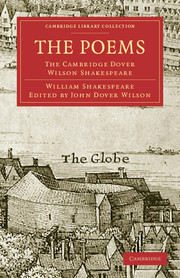INTRODUCTION
Published online by Cambridge University Press: 07 September 2010
Summary
Both the narrative poems belong to the period when, with only brief intervals, the London theatres were closed because of plague–August 1592 to April 1594–and there is no reason to doubt that it was this emergency which led Shakespeare to turn to the composition of these poems: a more dignified and, he may well have hoped, a more remunerative form of writing. If we could accept the story told by Rowe on the alleged authority of Davenant that Southampton ‘at one time, gave him a thousand Pounds, to enable him to go through with a Purchase which he heard he had a mind to’, his most sanguine hopes must have been more than realized, but the story has little claim to belief. At any rate, the greater prestige of the non-dramatic poem is quite enough to explain the unnecessarily puzzled-over description of Venus and Adonis in the Dedication as ‘the first heir of my invention’. (It did, in fact, precede in publication the first plays to appear: Titus Andronicus and the Bad Quarto of 2 Henry VI in 1594.)
After being extremely popular in their own day–by 1617 there had been ten (surviving) editions of Venus and Adonis and six of The Rape of Lucrece–these poems, though regularly reprinted in collected editions since 1778, sank into relative obscurity.
- Type
- Chapter
- Information
- The PoemsThe Cambridge Dover Wilson Shakespeare, pp. ix - xxxviPublisher: Cambridge University PressPrint publication year: 2009First published in: 1966

